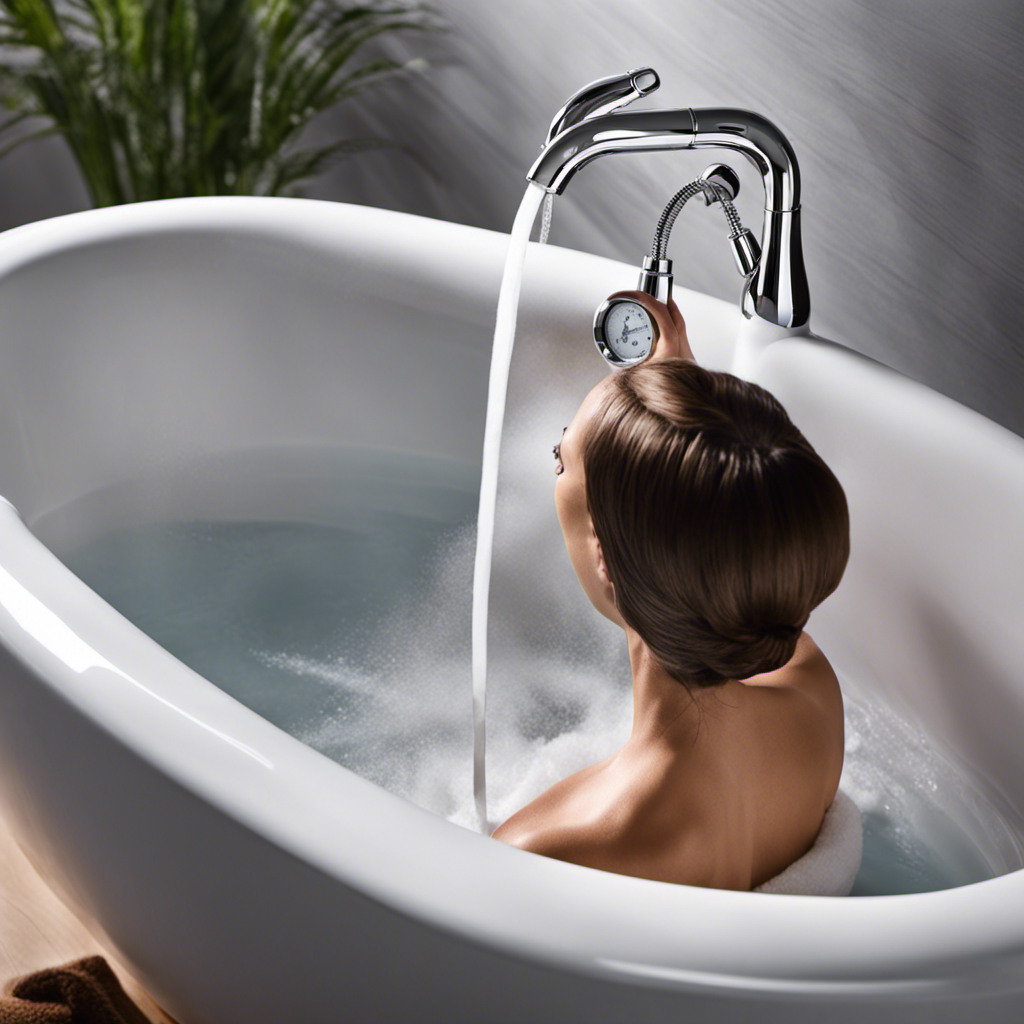Hey there!
Ever walked into your bathroom and felt like your bathtub could use a little sprucing up? Well, fret not!
I’m here to share my tried and true method for whitening your bathtub. Just like a painter with a blank canvas, we’re going to transform that dull and stained surface into a sparkling masterpiece.
So grab your cleaning supplies and let’s get to work!
Key Takeaways
- Consider using natural alternatives like baking soda and hydrogen peroxide paste or lemon juice to whiten your bathtub.
- Commercial cleaning products are specifically formulated for effective stain removal and may have longer-lasting effects.
- Prepare your bathtub for cleaning by gathering necessary supplies and creating a paste with baking soda and water for tough stains.
- When applying a whitening solution, wear gloves, apply it evenly across the surface, and follow the recommended time mentioned on the product label.
Choosing the Right Cleaning Products
To choose the right cleaning products for whitening your bathtub, you’ll want to look for ones specifically designed for removing stains and discoloration. When it comes to natural alternatives, there are a few options you can consider.
One option is using a mixture of baking soda and hydrogen peroxide. Simply create a paste with these ingredients, apply it to the stains on your bathtub, and let it sit for a few minutes before scrubbing it away.
Another natural alternative is using lemon juice. The acidic properties of lemon juice can help break down stains and brighten the surface of your bathtub. However, it’s important to note that while natural alternatives may be effective in the short term, they may not have the same long-term effects as commercial cleaning products.
Preparing Your Bathtub for Cleaning
First, make sure you’ve gathered all the necessary cleaning supplies. To effectively clean and whiten your bathtub, you’ll need a few key items. Start by grabbing a good quality bathtub cleaner, a scrub brush or sponge, a microfiber cloth, and some baking soda. These items will help you tackle tough stains and restore the shine to your bathtub.
Now, let’s move on to removing those stubborn stains. One of my favorite bathtub cleaning hacks is using a mixture of baking soda and water. Create a paste-like consistency and apply it to the stained areas. Let it sit for a few minutes, then scrub with your brush or sponge. Rinse thoroughly with water and wipe down with a microfiber cloth.
You’ll be amazed at how easily those tough stains disappear!
Applying the Whitening Solution
Now that you have gathered the necessary cleaning supplies, it’s time to apply the whitening solution. Here are the best techniques for applying the whitening solution:
-
Begin by wearing gloves to protect your hands from the strong chemicals in the solution. This will prevent any skin irritation or damage.
-
Use a sponge or soft cloth to apply the whitening solution evenly across the surface of the bathtub. Start from the top and work your way down, making sure to cover all areas.
-
Allow the solution to sit on the surface for the recommended amount of time, as mentioned on the product label. This will ensure that the solution has enough time to work its magic and remove stains effectively.
Common mistakes to avoid when applying the whitening solution:
-
Avoid using too much solution as it can lead to streaks or an uneven appearance on the bathtub.
-
Don’t forget to ventilate the area by opening windows or turning on fans. The fumes from the solution can be strong and harmful if inhaled for a long period.
-
Never mix different cleaning solutions together as it can create dangerous chemical reactions.
Now that you have applied the whitening solution, it’s time to move on to the next step of scrubbing and cleaning the surface.
Scrubbing and Cleaning the Surface
After applying the whitening solution, it’s important to scrub and clean the surface of the bathtub to remove any remaining stains or dirt.
To achieve a truly deep clean and remove those tough stains, I recommend using a scrub brush or sponge with abrasive bristles.
Start by wetting the surface of the bathtub and then apply a generous amount of cleaning solution.
Using firm pressure, scrub the surface in circular motions, paying extra attention to areas with stubborn stains.
Rinse the tub thoroughly with warm water to remove any residue.
For especially tough stains, you may need to repeat the process or use a specialized stain remover.
Once you’re satisfied with the results, dry the bathtub with a clean towel to prevent water spots or streaks.
Maintaining a Clean and White Bathtub
To maintain a clean and white bathtub, it’s important to regularly scrub and clean the surface. Here are three practical tips to help you keep your bathtub looking pristine:
-
Preventing stains and discoloration: Avoid leaving items such as wet towels or hair dye in the bathtub for extended periods. These can cause unsightly stains and discoloration. Additionally, be mindful of using harsh chemicals or abrasive cleaners that can damage the surface and lead to discoloration.
-
DIY natural whitening solutions: For an effective and eco-friendly solution, mix equal parts baking soda and hydrogen peroxide to form a paste. Apply the paste to the stained areas, let it sit for a few minutes, and then scrub gently with a sponge or brush. Rinse thoroughly to reveal a whiter bathtub.
-
Regular maintenance: Implement a regular cleaning routine that includes wiping down the bathtub after each use, using a non-abrasive cleaner, and scrubbing away any soap scum or residue. This will help prevent the buildup of dirt and grime, keeping your bathtub looking clean and white.
Conclusion
In conclusion, I’ve shared with you an effective method to whiten your bathtub. By choosing the right cleaning products and properly preparing the surface, you can achieve a clean and white bathtub.
Remember to scrub and clean the surface thoroughly, and maintain its cleanliness regularly. As the saying goes, ‘A clean bathtub is a happy bathtub.’
So go ahead and give your bathtub the care it deserves, and enjoy the sparkling results!










